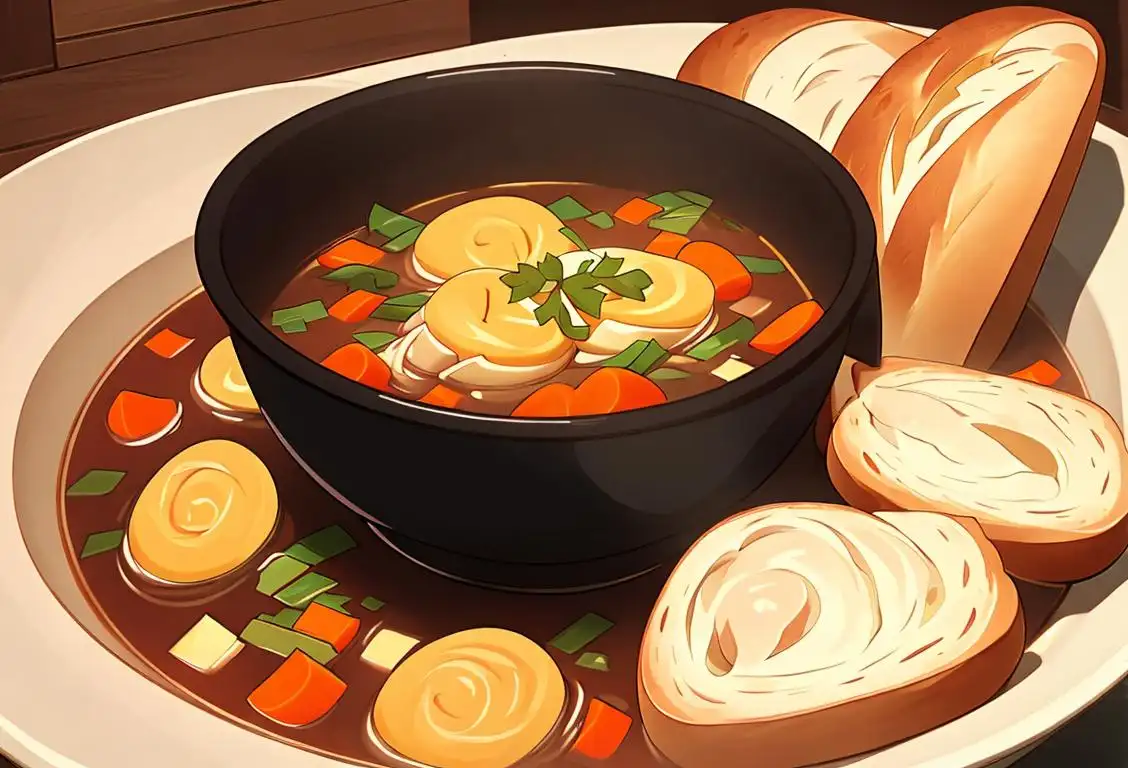National Soup Day

Welcome to National Soup Day, the holiday that warms our hearts and fills our bellies with deliciousness! On this special day, we celebrate the ultimate comfort food that has been simmering its way into our hearts for centuries. Whether you prefer a hearty bowl of chicken noodle, a creamy bisque, or a spicy chili, there's a soup out there for everyone. So grab your ladles and get ready to dive into a steaming bowl of goodness!
When is Soup Day?
It's national soup day on the 4th February.
A Brief History of National Soup Day
While the exact origins of National Soup Day are shrouded in mystery (perhaps hidden under a thick broth?), the celebration of soup has been around for centuries. Archaeologists have discovered evidence of soup-making dating back to 20,000 B.C., when cavemen realized that boiling water with vegetables and meats yielded a tasty and satisfying meal.
In ancient times, soup was often considered a luxurious delicacy reserved for the upper class. In fact, the word 'restaurant,' originally used to describe a type of soup, comes from the French word 'restaurer,' which means 'to restore' or 'to replenish.'
Over time, soup became more accessible to the masses, and different countries and cultures developed their unique variations. From Italian minestrone to Indian mulligatawny, soup has become a worldwide culinary phenomenon.
History behind the term 'Soup'
6000 BC
The Birth of Soups
Soup can be traced back to around 6000 BC, making it one of the oldest forms of prepared food. The word 'soup' itself comes from the Latin word 'suppa,' which means 'bread soaked in broth.' In ancient times, people would combine meat, vegetables, and grains in a pot and simmer them to create a nourishing and flavorful liquid food.
15th century
Origin of the word 'soup'
The term 'soup' originates from the Middle Ages, specifically in the 15th century. It comes from the Old French word 'soupe' which means a slice of bread soaked in liquid. During this time, soups were often made by placing a piece of bread at the bottom of a bowl and then pouring hot liquid over it. The bread would absorb the flavors and become soft.
400 BC
Ancient Greek Influence
The ancient Greeks were known for their culinary innovations, and they played a significant role in the development of soups. In 400 BC, a Greek cook named Soterides introduced a recipe for a lentil soup known as 'ttavas.' This marked a turning point in soup culture as it became a popular dish in ancient Greece, showcasing the versatility and endless possibilities of soup-making.
17th century
Evolution of soup as a culinary dish
In the 17th century, soups started to become more sophisticated and began to include a variety of ingredients such as meats, vegetables, and spices. This period witnessed the emergence of soup as a popular culinary dish among both the upper and lower classes. The availability of different ingredients and the creativity of chefs led to the development of numerous soup recipes from around the world.
9th Century
Medieval Soups
During the Middle Ages, soups started evolving and diversifying across Europe. Cookbooks from the 9th century mention various soup recipes made with ingredients such as fish, meat, vegetables, and herbs. Soup was not only a delicious and warming dish but also a way to use up leftovers and minimize food waste.
18th century
Soup and culinary advancements
The 18th century marked a significant advancement in culinary techniques, and soup played a prominent role in this progression. French chefs, such as Marie-Antoine Carême, revolutionized the concept of soup by introducing refined techniques like straining and blending to create smooth and velvety textures. This era witnessed the rise of cream-based soups and the inclusion of exotic spices, herbs, and seasonings in soup recipes.
18th Century
Soup for the Masses
In the 18th century, soup became a staple food for the masses due to its affordability and ability to feed large groups of people. The Industrial Revolution brought advancements in food production, making ingredients more accessible and cheaper. Soups like beef stew, split pea soup, and potato soup gained popularity as hearty and economical meals.
19th century
Soup as a symbol of nourishment during hard times
During the 19th century, soup became a symbol of nourishment and sustenance, particularly during times of economic hardship. Soup kitchens and charity organizations often served soup as a means to provide a warm meal to those in need. This era also saw the advent of canned soups and bouillon cubes, making soup more accessible to the masses and aiding in its popularity.
19th Century
The Rise of Canned Soups
The invention of canning in the early 19th century revolutionized the way soups were consumed. Canned soups provided convenience and a longer shelf life, making them an instant hit. In 1897, a chemist named Dr. John T. Dorrance developed condensed soup, particularly tomato soup, which became one of the most iconic canned soups in history.
20th century
Diversification of soup culture
The 20th century brought about a diversification of soup culture, as different regions around the world embraced their own unique flavors and recipes. Various countries developed their signature soups, such as Italy's minestrone, Japan's miso soup, and Mexico's tortilla soup. Additionally, the invention of instant soup by Dr. John T. Dorrance in 1910 revolutionized the convenience and availability of soups.
20th Century
Soup Goes Global
In the 20th century, soup transcended borders and became an integral part of various world cuisines. Influenced by immigration and cultural exchange, globally recognized soups like French onion soup, Italian minestrone, Chinese hot and sour soup, and Mexican tortilla soup gained popularity worldwide. Soup's adaptability to local ingredients and flavors allowed it to conquer the hearts and taste buds of people all over the globe.
Present day
Continued popularity and creative adaptation
In the present day, soup remains a beloved and versatile dish in many cultures globally. It continues to evolve with contemporary culinary trends, incorporating new ingredients and innovative cooking methods. With the rise of plant-based diets, there has been a surge in vegetarian and vegan soup recipes. Moreover, chefs and food enthusiasts experiment with fusion flavors, combining elements from different cuisines to create exciting and unique soup experiences.
Did you know?
Did you know that soup is a popular hangover remedy in many cultures? It's believed that the combination of warm broth and nourishing ingredients helps to replenish the body after a night of overindulgence. So the next time you have a little too much fun, a bowl of soup might just be the cure you need!Tagged
food fun historyFirst identified
14th March 2016Most mentioned on
4th February 2021Total mentions
371Other days
Senior Citizens Day
French Fries Day
Hot Chocolate Day
Lasagna Day
Jelly Bean Day
Chili Day
Nacho Day
Vodka Day
Martini Day
Pastry Day









